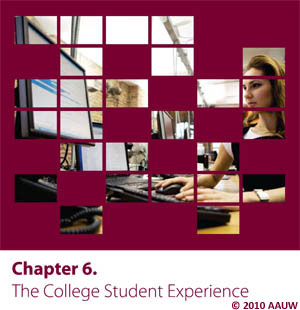


What Works for Women in Physics?
Barbara Whitten, a professor of physics and women's studies at Colorado College, compared what she called "successful" physics departments, where women made up about 40 percent of bachelor's degree earners, with more "typical" physics departments, where women made up closer to the national average of around 20 percent of graduates, to see what set successful departments apart from more typical ones.
 Whitten and her colleagues found that the major difference between successful and typical departments was departmental culture. Specifically, they found that the most successful programs integrated students into the department soon after they declared a physics major and reached out to students taking introductory courses who might potentially major in physics. Successful departments often had a physics lounge and sponsored seminars, trips, and other social events. These activities provided opportunities for students to learn more about different applications of physics and career opportunities and also provided opportunities for faculty and students to interact more informally and forge relationships. According to Whitten, most typical departments do some of these things, but successful departments do more of them and more consistently and personally.
Whitten and her colleagues found that the major difference between successful and typical departments was departmental culture. Specifically, they found that the most successful programs integrated students into the department soon after they declared a physics major and reached out to students taking introductory courses who might potentially major in physics. Successful departments often had a physics lounge and sponsored seminars, trips, and other social events. These activities provided opportunities for students to learn more about different applications of physics and career opportunities and also provided opportunities for faculty and students to interact more informally and forge relationships. According to Whitten, most typical departments do some of these things, but successful departments do more of them and more consistently and personally.
Whitten was especially impressed with the model of historically black colleges and universities (HBCUs) for creating effective and supportive departmental cultures that help recruit and retain women science majors. HBCUs produce a disproportionate number of African American women physicists. And more than half of all African American physics degree holders, women and men at all levels, graduate from HBCUs.
HBCUs do one crucial thing that Whitten's team did not observe at other schools they visited: The schools provide a path toward a degree for students who do not come to college fully prepared to be physics majors.
"Most schools don't recognize a category of student who would like to be a physics major, is interested in physics, and might be good at physics but who does not have the preparation straight from high school," Whitten said. The typical model is someone who has decided in high school that she or he wants to be a physics major and declares the major in college. HBCUs were the only schools that provided an alternative path to the major. Whitten believes that "if we could make a path like that in all schools, we would increase the diversity of physics majors."
In your experience, does allowing for different pathways into a major increase the diversity of science, technology, engineering, and mathematics students? Do you have any experience with this approach that you'd like to share?

Laura,
I missed your comment until today. I think the class you describe is fantastic! It is relevant and need not be remedial. Great approach -- now, how do we get the concept to see larger distribution and, more importantly, acceptance?
Marian
Hi Christi and Marian,
Yes, I agree too, and more cogent to this argument, Barbara Whitten herself agrees and has begun teaching that way, serving as a role model for other physics teachers. One course she teaches involves the class taking on remodeling houses for low income seniors near the college. They study heat flow, for example, and look into characteristics of insulators, sealing of windows, other ways to keep heat from escaping. The homeowner ends up with a far more affordable heating bill (which in Colorado is a big improvement), the environment is served by having less energy wasted, and the kids learn physics. She talked at a meeting in Claremont last year to a conference on women in science, and we were all very impressed with her design. The students really give the course rave reviews, both men and women, and some of the women say later it was the cause of their choosing physics as a major.
cheers,
Laura
Marian,
I think your comment is very insightful, and I agree.
Christi
Christi,
I think you have touched upon a key attribute connected with getting women into STEM fields: different. In your description above, providing an alternative path implies that a remedial path is required. If we extend that concept to be more general, I think you have hit a home run.
I held back in the discussion of women in computer science because my thoughts didn’t fit the discussion path of the other participants. I truly believe that the primary barrier to women in CS is the focus of the classes and the way the subject matter is taught. My observation is that women are more likely to appreciate computers for the problems they can solve than for the computers themselves. The view of the computer as a toy seems far more male than female. A different approach is required; not easier or less rigorous, just different.
The same logic may apply to physics as well; is there a way to present introductory physics that is less focused on the esoteric and more based in the world as it is relevant to young women? I believe many young women enter introductory physics classes, observe that they look at the world differently from their male peers and professor, and conclude that they are not cut out for physics. More women in the classes would also help, but perhaps a different approach might intrigue women enough to keep them enrolled? It’s worth considering.
Marian















